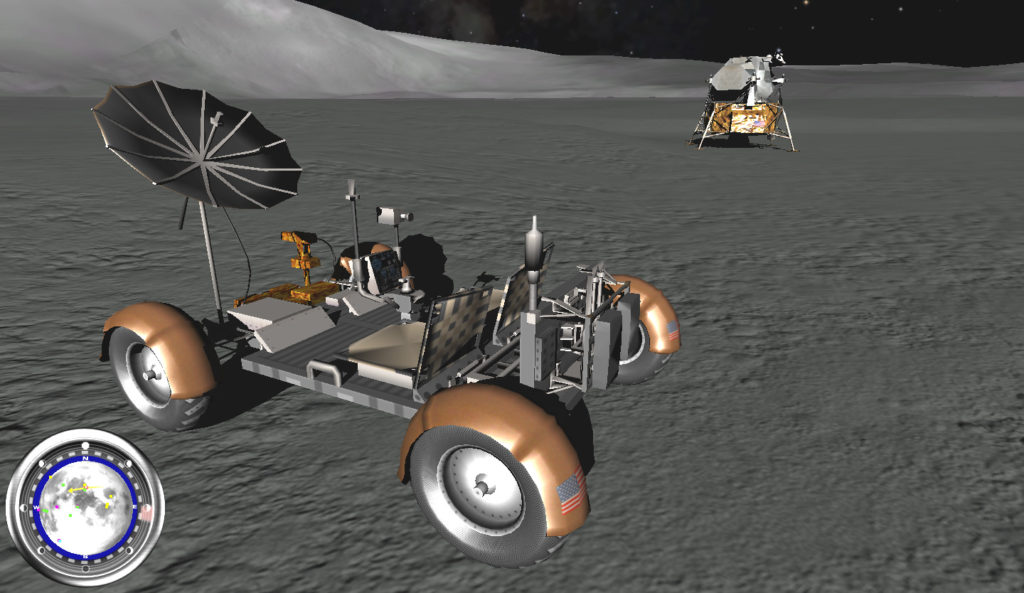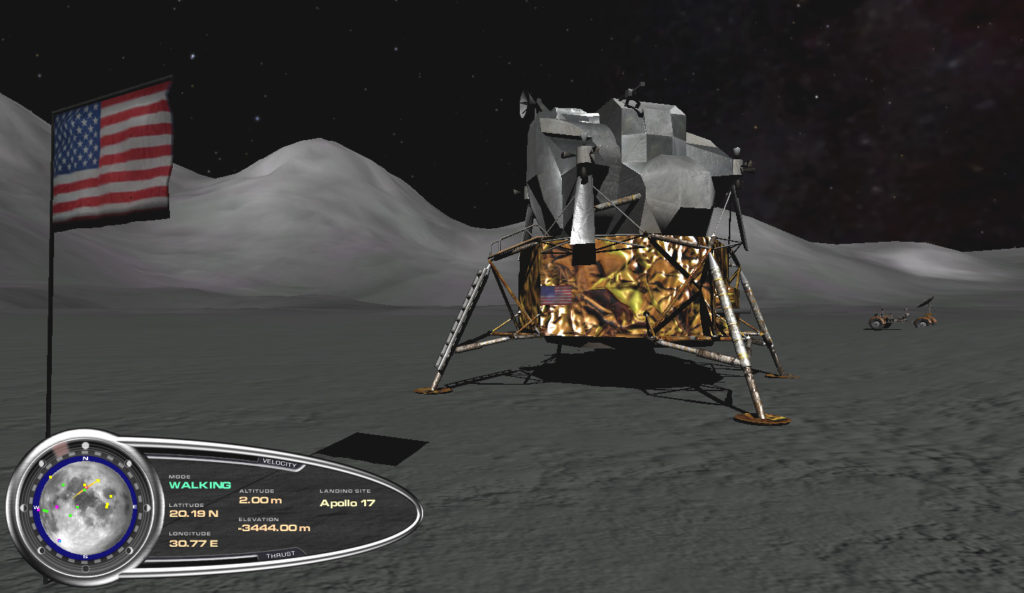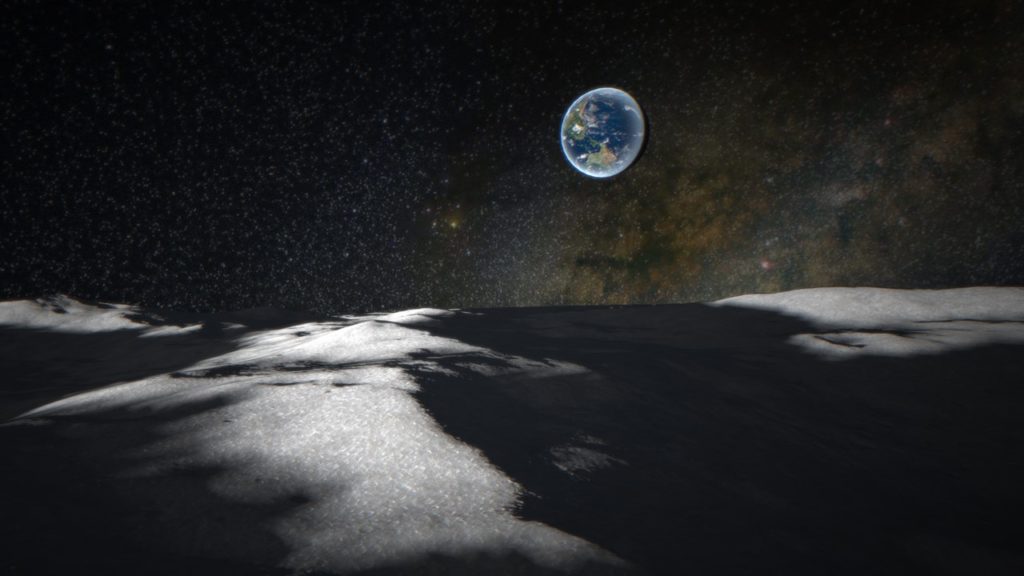Our Story
Many of our Virtual Moon team share a similar memory of how our passion for the Moon was ignited. We were all witnesses to history being made as we watched the live broadcast from the Moon of Neil Armstrong taking his first steps on the lunar surface. My own personal memory of the event—which I have come to regard as the single greatest moment in all of human history so far—is of being excited at the thought of a future where anyone could one day go visit the Moon and I certainly wanted to be among those. As a ten-year-old in July of 1969, I figured that in another 3 of my lifetimes, somewhere around the year 2000, that future that I was imagining would have become a reality. By the year 2000, I thought, I would be able to stand on the surface of the Moon and look back at Earth!
Alas, it was not to be. As the year 2000 arrived, we had failed to build the future I had dreamed of and hoped for. Worse, there was no plan in place to make it happen. America and the world had abandoned the vision. I despaired that my dream of one day visiting the Moon was never going to happen.
Reflecting on this I realized that I had no right to feel disappointed. After all, what had I personally done to contribute, in even the smallest measure, to making that imagined future a reality? The painfully honest answer is that I had never lifted a finger; I had done absolutely nothing!
It’s not that I imagined that anything that I could have done in those 30 years that elapsed since I saw the live broadcast from the Moon would have made any difference at all. It was just a feeling that there were countless things within my power that I could have done, regardless of the outcome, that I just did not do. If you have a real and persistent dream, you must do whatever is in your power to work towards the realization of that dream.
I went online and looked for groups and organizations that shared my passion for the Moon. I found an organization called the Space Frontier Foundation. Their mission statement hit home in a very profound way: “To open the Space Frontier for all of Humanity within our lifetime”. They were having a “Return To The Moon” conference in Las Vegas. I readily signed up for membership and registered for the Las Vegas Conference. My thinking at the time was that I would volunteer for any job or task that needed to be done. Even if it was just stuffing and mailing envelopes. No matter how menial the task might be, it would be more than doing nothing.
The “Return To The Moon” conference was an amazing experience! I had expected that a few thousand people would be attending. I was initially disappointed that only about a hundred people showed up. But that turned out to be the best part of it: with only a hundred people at the conference I got to meet and talk to almost everyone there. Fast forward 20 years to today: many of those people are now leaders in the private commercial efforts to build new launch systems and develop the technologies that will enable our conquest of space.
As a result of my involvement and my new network of connections within the space advocacy community, I looked for more opportunities to contribute. I became a very active member of the Space Frontier Foundation, taking on roles of increasing responsibility. Eventually, I became manager of the Return To The Moon project and I organized the Return To The Moon IV and Return To The Moon V conferences. Our conference chairs and keynote speakers were Captain John Young for RTM IV and Andrew Chaikin for RTM V. One particular highlight of RTM V was the presentation of an award to Dr. George Mueller who headed the Office of Manned Space Flight at NASA which included a 5-minute tribute video highlighting Dr. Mueller’s leadership of the Apollo program from 1963 to 1969.
Concurrently with my increased involvement and work with the SFF, I created a company called Lunar Explorer, found private investors, and created the world’s first fully immersive, interactive, virtual reality simulation of the Moon, titled Lunar Explorer.
Lunar Explorer helped me realize my dream of one day visiting the Moon. Using the VR mode of Lunar Explorer, I have been to every Apollo landing site, the Surveyor sites, and all of the Soviet Luna sites. I have walked around the surface experiments at each Apollo site, walked from the Apollo12 landing site to Surveyor 3, stood at the edge of Hadley Rille, “skied” down the slopes of Copernicus Crater and visited many hundreds of other locations.

As of late 2004, Lunar Explorer was available for sale online through the Space Frontier Foundation, The Moon Society, the National Space Society, Space.com, as well as on Amazon).

By happy coincidence, even though it was created over 15 years ago, Lunar Explorer runs quite well on any Windows 10 PC or laptop. Understandably, we are very proud of Lunar Explorer. To this day, it remains the world’s ONLY fully immersive, interactive, Virtual Reality simulation of the Moon—a notable achievement.
When providing your contact information in the “Join us” page, please let us know if you would like a downloadable version of the original Lunar Explorer simulation and we will be happy to provide it.
Lunar Explorer was an ambitious project. 15 years ago, however, there were no first-wave consumer-level VR headsets on the market anymore, and the new wave VR headsets were still a decade away. So, even though LE was a fully implemented VR experience, most users who purchased it were only able to experience it on their computer displays. That absence of full sensory immersion greatly diminished the impact of the user experience. In spite of this, we received universal acclaim from many users sharing their unsolicited reactions via emails.
And that brings us to where we are today
Since the advent of Oculus, Vive, and other VR headsets, we have been working on a plan to create a new version of Lunar Explorer that will run on these new VR platforms. It will include all of the features of the original Lunar Explorer Version 1.0 but will be massively upgraded with new high-resolution Lunar surface topography from NASA’s Lunar Reconnaissance Orbiter mission. It will have photorealistic 3D graphics quality, very high resolution, and many new interactivity features.
We have put together a team of world-class experts and partners to make Virtual Moon a reality. The team includes retired NASA Astronaut and MIT Professor Jeff Hoffman, former Disney Imagineering VP, inventor and former NYU Professor Eric Rosenthal, Star Trek special effects producer Dan Curry, and “A Man On The Moon” author Andrew Chaikin, among other well-known leaders in the space and space technology community.
Development of the Virtual Moon simulation will be done by the multi-award-winning VR/AR company E-spaces, the world’s oldest continuously operating VR/AR studio founded and led by VR veteran Philippe van Nedervelde. Philippe shares similar memories of being a witness to history during the Apollo years and an even bigger passion for space and for the Moon than mine. Since his teenage years, he has accumulated an impressive list of accomplishments as a proponent of the vision of our future in space.
When Philippe and I first made contact, we formed an immediate friendship about our shared passion for creating a direct, personal, and deeply inspiring experience of space for everyone. The decision to move forward as partners on Virtual Moon was instantaneous.
Our entire team at Virtual Moon is excited to bring you this unique experience. Until you can physically go to the Moon, Virtual Moon will take you there virtually.
Thank you for your interest!
We hope to welcome you all to the Moon in the next few months.
We will update our progress here regularly. Please come visit again… and let all your friends know.
Manny Pimenta
Founder and CEO
Virtual Moon
info@virtualmoon.space

The Earth as seen from the Moon’s South Pole